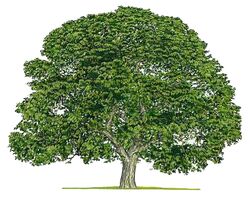Difference between revisions of "Black Walnut"
| Line 2: | Line 2: | ||
== Description == | == Description == | ||
| − | Black walnuts are large, deciduous trees that have an average height of 75 to 100 feet [2], with a maximum height of 150 feet. [3] They typically mature within 150 years. [4] The crown is oval or rounded and has a spread of 75 to 100 feet. [2] The leaves are feather-compound and alternate on the branches. Each leaf has anywhere from 15 to 23 leaflets that are finely-toothed, narrow, and slightly hairy underneath. The leaves are 1 foot to 2 feet long. When crushed, the leaves often have a spicy scent. Twigs are hairless and have white-woolish buds. The bark is dark, deeply grooved, and has dull ridges. Black walnuts have an average trunk diameter of two to four feet with a maximum diameter of six feet. [ | + | [[File:BlackWalnutLeaf.jpg|250px|thumb|right]] |
| + | Black walnuts are large, deciduous trees that have an average height of 75 to 100 feet [2], with a maximum height of 150 feet. [3] They typically mature within 150 years. [4] The crown is oval or rounded and has a spread of 75 to 100 feet. [2] The leaves are feather-compound and alternate on the branches. Each leaf has anywhere from 15 to 23 leaflets that are finely-toothed, narrow, and slightly hairy underneath. The leaves are 1 foot to 2 feet long. When crushed, the leaves often have a spicy scent. Twigs are hairless and have white-woolish buds. The bark is dark, deeply grooved, and has dull ridges. Black walnuts have an average trunk diameter of two to four feet with a maximum diameter of six feet. [3] The blooms appear from May to June, are yellowish-green, and are insignificant. [2] The fruits appear from October to November [3], are showy, and have edible kernels. The fruits appear as large spherical nuts with yellow-green husks that turn black when the fruit falls. They are tolerant of rabbits and droughts. [2] | ||
The genus name Juglans comes from the two Latin words jovis and glans meaning Jupiter and acorn, respectively. The name nigra means black, specifically referring to the dark bark and nuts. [2] | The genus name Juglans comes from the two Latin words jovis and glans meaning Jupiter and acorn, respectively. The name nigra means black, specifically referring to the dark bark and nuts. [2] | ||
== Habitat and Range == | == Habitat and Range == | ||
| − | [[File:BlackWalnutMap.png| | + | [[File:BlackWalnutMap.png|150px|thumb|left]] |
| + | Black walnuts are native to North America and can most often be found growing in riparian zones. [1] They prefer moist, well-draining [[soil]], that is organically rich and in full sun. These trees can not tolerate shade. [3] Their range extends from southern Minnesota, Wisconsin, Michigan, Ontario, and New York, south to eastern Texas and northern Louisiana and Florida. It also extends from the east coast of Pennsylvania, Delaware, Maryland, Virginia, and North Carolina, west to eastern Nebraska, Kansas, Oklahoma, and Texas. [1] | ||
| + | |||
| + | |||
| + | |||
| + | |||
| + | |||
| + | |||
== Taxonomy == | == Taxonomy == | ||
Revision as of 13:02, 8 May 2023
Description
Black walnuts are large, deciduous trees that have an average height of 75 to 100 feet [2], with a maximum height of 150 feet. [3] They typically mature within 150 years. [4] The crown is oval or rounded and has a spread of 75 to 100 feet. [2] The leaves are feather-compound and alternate on the branches. Each leaf has anywhere from 15 to 23 leaflets that are finely-toothed, narrow, and slightly hairy underneath. The leaves are 1 foot to 2 feet long. When crushed, the leaves often have a spicy scent. Twigs are hairless and have white-woolish buds. The bark is dark, deeply grooved, and has dull ridges. Black walnuts have an average trunk diameter of two to four feet with a maximum diameter of six feet. [3] The blooms appear from May to June, are yellowish-green, and are insignificant. [2] The fruits appear from October to November [3], are showy, and have edible kernels. The fruits appear as large spherical nuts with yellow-green husks that turn black when the fruit falls. They are tolerant of rabbits and droughts. [2]
The genus name Juglans comes from the two Latin words jovis and glans meaning Jupiter and acorn, respectively. The name nigra means black, specifically referring to the dark bark and nuts. [2]
Habitat and Range
Black walnuts are native to North America and can most often be found growing in riparian zones. [1] They prefer moist, well-draining soil, that is organically rich and in full sun. These trees can not tolerate shade. [3] Their range extends from southern Minnesota, Wisconsin, Michigan, Ontario, and New York, south to eastern Texas and northern Louisiana and Florida. It also extends from the east coast of Pennsylvania, Delaware, Maryland, Virginia, and North Carolina, west to eastern Nebraska, Kansas, Oklahoma, and Texas. [1]
Taxonomy
- Kingdom- Plantae (Plant)
- Phylum- Tracheophyta (Vascular Plants)
- Class- Dicotyledons (Flowering Plants)
- Order- Fagales (Flowering Plants)
- Family- Juglandaceae (Walnut Family)
- Genus- Juglans (Walnut Trees)
- Species- Juglans nigra (Black Walnut)
- Genus- Juglans (Walnut Trees)
- Family- Juglandaceae (Walnut Family)
- Order- Fagales (Flowering Plants)
- Class- Dicotyledons (Flowering Plants)
- Phylum- Tracheophyta (Vascular Plants)
Uses
Ecological Impact
References
[1] https://en.wikipedia.org/wiki/Juglans_nigra
[2] https://www.missouribotanicalgarden.org/PlantFinder/PlantFinderDetails.aspx?kempercode=a875
[3] Petrides, George A. Peterson Field Guides: Eastern Trees. Illustrated by Janet Wehr, New York City, Houghton Mifflin Harcourt, 1998.
[4] https://plants.usda.gov/DocumentLibrary/factsheet/pdf/fs_juni.pdf


